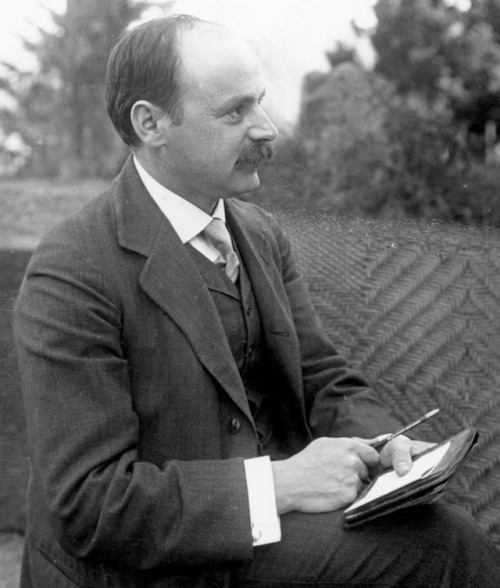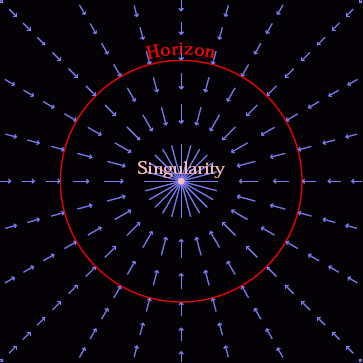Karl Schwarzschild






Karl Schwarzschild
He provided the first exact solution to the Einstein field equations of general relativity, for the limited case of a single spherical non-rotating mass, which he accomplished in 1915, the same year that Einstein first introduced general relativity. The Schwarzschild solution, which makes use of Schwarzschild coordinates and the Schwarzschild metric, leads to a derivation of the Schwarzschild radius, which is the size of the event horizon of a non-rotating black hole.
Schwarzschild accomplished this while serving in the German army during World War I. He died the following year from the autoimmune disease pemphigus, which he developed while at the Russian front. Various forms of the disease particularly affect people of Ashkenazi Jewish origin.
Asteroid 837 Schwarzschild is named in his honour, as is the large crater Schwarzschild, on the far side of the moon. (source) (biography) (more)
More Posts from Csmsdust and Others
Unusual antibiotic killing mechanism we just published in Nature
Our study about the unusual molecular mechanism behind the antibiotic activity of teixobactin can be read open access here:
https://www.nature.com/articles/s41586-022-05019-y

Figure: The target of teixobactin are bacteria-specific molecules (e.g. they do not exist in human cells) in outer membranes of bacteria. Teixobactin sits on the membrane and aggregates into fibrils, damaging the bacterial membrane and hindering its functions. We got these images by atomic force microscopy that has nanometer resolution. We can see individual teixobactin molecules coming to the bacterial membrane and forming the aggregate.
This is the first star from my research on antibiotics that I started at my postdoc in the Netherlands. More are coming out soon! The very first star was published in Nature, the most read journal in life sciences. I am in scientific heaven!


https://www.marktechpost.com/2024/12/29/researchers-from-mit-sakana-ai-openai-and-swiss-ai-lab-idsia-propose-a-new-algorithm-called-automated-search-for-artificial-life-asal-to-automate-the-discovery-of-artificial-life-using-vision-lang/

x


Really interesting part of the book I just started reading


In many ways, scientific analyses of consciousness suffer from the same limitations and constraints as cosmological theories: right right at the outset, certain manipulations and observations cannot be carried out.

The books I'm reading at the moment.

Meditations by Marcus Aurelius - I love this book. It puts you in the perspective of the time and space you occupy, I found a lot of my own thinking and feelings within the pages of this book. A guy born in AD 121 has very clear view on life that is still relevant today.

Great Adaptations by Kenneth Catania - A professor of biological sciences takes you on a journey with him while he studies various animals adaptive abilities. Star nosed moles, electric eels, tentacled snakes... Very interesting insight in how these creatures evolved and adapted.

What we cannot know by Marcus du Sautoy - Explains concepts from the ground up, I like the illustrations that accompany the text and practical examples. Lays foundations to the known and wonders into the future of research and the possibilities that come with it as well as limitations. Covering themes from quantum physics and cosmology to sensory perception and neuroscience.

Labyrinths of reason by William Poundstone - "Blue sky, sunshine, deja vu glazed with dread." How do you know this isn't all a dream? Is anything certain? Ontology, logic, mathematics, deduction, epistemology, memory formation, paradoxes and puzzles.

A brain for numbers by Andreas Nieder - Humans' understanding of numbers is intuitive. How are infants able to perceive numbers even before they learn the words for them? How do our brains process numbers? Can animals count? He shows how it is an adaptive ability and that plenty of animals have the number sense too. There is a variety of research and supporting evidence mentioned which I really like.

Archaeologists believe that around 417 cities, towns, and villages made up the unified civilization.
Remains of architectural forms and patterns, ceramics, sculptural art, architectural patterns, and unifying causeway constructions.
The magnitude of the labor int he construction of massive platforms, palaces, dams, causeways, and pyramids dating to the Middle and Late Preclassic periods, suggests a power to organize thousands of workers.
-
 jupiterrosescrolls reblogged this · 1 month ago
jupiterrosescrolls reblogged this · 1 month ago -
 xj4x liked this · 1 month ago
xj4x liked this · 1 month ago -
 thebongomediaempire reblogged this · 1 month ago
thebongomediaempire reblogged this · 1 month ago -
 thebongomediaempire liked this · 1 month ago
thebongomediaempire liked this · 1 month ago -
 cetaceous liked this · 4 months ago
cetaceous liked this · 4 months ago -
 insidewarp reblogged this · 4 months ago
insidewarp reblogged this · 4 months ago -
 saltypolicewonderland liked this · 8 months ago
saltypolicewonderland liked this · 8 months ago -
 ur-not-calling-it-the-enterprise reblogged this · 9 months ago
ur-not-calling-it-the-enterprise reblogged this · 9 months ago -
 xploseof reblogged this · 9 months ago
xploseof reblogged this · 9 months ago -
 jahanbaros liked this · 10 months ago
jahanbaros liked this · 10 months ago -
 littleplasticspaceship reblogged this · 10 months ago
littleplasticspaceship reblogged this · 10 months ago -
 ruralobserver reblogged this · 10 months ago
ruralobserver reblogged this · 10 months ago -
 ruralobserver liked this · 10 months ago
ruralobserver liked this · 10 months ago -
 hamadaaa000 liked this · 10 months ago
hamadaaa000 liked this · 10 months ago -
 theatheistgirl liked this · 10 months ago
theatheistgirl liked this · 10 months ago -
 carnalreincarnated liked this · 10 months ago
carnalreincarnated liked this · 10 months ago -
 lovemusicnart reblogged this · 10 months ago
lovemusicnart reblogged this · 10 months ago -
 cezar-dahl liked this · 10 months ago
cezar-dahl liked this · 10 months ago -
 pheonix1t23 liked this · 10 months ago
pheonix1t23 liked this · 10 months ago -
 blignick liked this · 10 months ago
blignick liked this · 10 months ago -
 lovemusicnart liked this · 10 months ago
lovemusicnart liked this · 10 months ago -
 gregorlenko liked this · 10 months ago
gregorlenko liked this · 10 months ago -
 the-black-cats liked this · 10 months ago
the-black-cats liked this · 10 months ago -
 alysettenymphaneth liked this · 10 months ago
alysettenymphaneth liked this · 10 months ago -
 umyeahhhhh0451 liked this · 10 months ago
umyeahhhhh0451 liked this · 10 months ago -
 spacedoutblogger liked this · 10 months ago
spacedoutblogger liked this · 10 months ago -
 mformoegso liked this · 10 months ago
mformoegso liked this · 10 months ago -
 nobiramone liked this · 10 months ago
nobiramone liked this · 10 months ago -
 tthel reblogged this · 10 months ago
tthel reblogged this · 10 months ago -
 tthel liked this · 10 months ago
tthel liked this · 10 months ago -
 hairw3avekillh3r liked this · 10 months ago
hairw3avekillh3r liked this · 10 months ago -
 hairw3avekillh3r reblogged this · 10 months ago
hairw3avekillh3r reblogged this · 10 months ago -
 csmsdust reblogged this · 10 months ago
csmsdust reblogged this · 10 months ago -
 quiggsy reblogged this · 10 months ago
quiggsy reblogged this · 10 months ago -
 quiggsy liked this · 10 months ago
quiggsy liked this · 10 months ago -
 couture-ephemeralia liked this · 10 months ago
couture-ephemeralia liked this · 10 months ago -
 bill64us liked this · 10 months ago
bill64us liked this · 10 months ago -
 claudiacder reblogged this · 10 months ago
claudiacder reblogged this · 10 months ago -
 info-of-all-kinds reblogged this · 10 months ago
info-of-all-kinds reblogged this · 10 months ago -
 mieanson reblogged this · 10 months ago
mieanson reblogged this · 10 months ago -
 hattedaviator liked this · 10 months ago
hattedaviator liked this · 10 months ago -
 onewigglyworm liked this · 10 months ago
onewigglyworm liked this · 10 months ago -
 kurotaurus17 reblogged this · 10 months ago
kurotaurus17 reblogged this · 10 months ago -
 cancel12 liked this · 10 months ago
cancel12 liked this · 10 months ago
